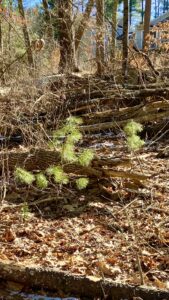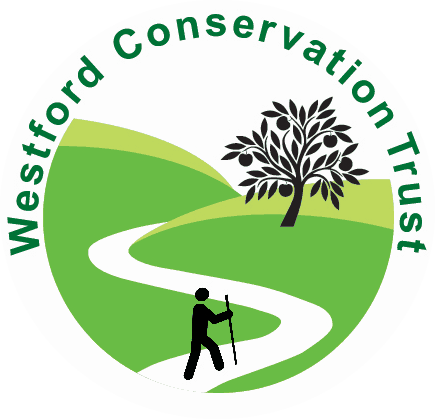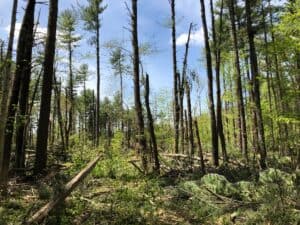
In May of 2020, northern Westford experienced a furious microburst of wind. It came on very suddenly and knocked down huge swathes of big old pine trees in its path. Our condo and some others were damaged by trees falling. The forest to the north of us which borders on Snake Meadow Brook and Keyes Pond was severely impacted. Trees in a defined path were uprooted and tossed down like Pick-Up Sticks. The forest looked like it had been hit by a bomb. Residents were understandably concerned. We could repair the condos, but what about the forest? Some people thought we should clear away all the downed trees, (several acres) and plant some young ones. I knew this was not the right approach, and fortunately, it turned out to be much too expansive to do.
I was sorry to lose the forest, but excited to see how it would heal itself naturally. Given increased sun, some understory plants flourished. There was an increased growth of some shrubs such as highbush blueberry and clubmosses. Tiny white pines started to peek their heads above ground. The mighty fallen pines had left many seeds in the ground, which were just waiting for sun to emerge. White pines thrive in open, sunny spaces. Some small oaks and birches also started growing. The large old downed tree trunks and branches protected these seedlings as they got their start.
Recently I walked around this area and took some photos of the young pines. They are four or five years old now. I counted the levels or whorls of branches which told me their ages (this method only works for evergreens). The tallest youngsters are the ones which had access to the most sun. Those growing in the most open areas are growing 4-6 inches a year. Others that are growing in slightly more shade are the same age, but are growing only 1-2 inches a year.
Wildlife in this area has adjusted too: gray squirrels and chipmunks search in vain for pine cones and acorns. Some species of warblers and flycatchers that prefer open canopy are visiting more often now. Nature is always changing and adjusting to natural conditions. This forest, if undisturbed for many years, will eventually heal itself and become old growth pine and oak again, but there will be many stages of its development. I will enjoy following the natural course of its resurrection and change.
Many thanks for your reports this month. Please send reports by February 29, to appear in next month’s column. You can e-mail me at mariancharman@gmail.com.
February Reports
Marian/Bill Harman, Old Colony Drive. February 3, sunny! (first sun in ten days), 30’s. At the feeder: two downy woodpeckers, one red-bellied woodpecker, six juncos. Feb. 12, 50’s. First red-wings and grackles in the trees at our front yard. Cowbird heard. Feb. 13, 33 degrees, light snow. February 19, 34 degrees, sunny, breezy. A walk to the beaver dam: heard red-bellied woodpecker, chickadee, titmouse, lot of red-wings and grackles near the condos. They’re not on territory yet—the river and swamp are frozen. Mourning doves heard. I took photos of the sapling pines that are regenerating in the blown-down area of the forest (the microburst came through in 2020). The oldest are about 5 years old. The trees that are growing fastest are in the most sunny spots. February 23, three Tom turkeys under the feeder. They’re still getting along with each other, so not breeding yet. Their heads are getting a bit red though. Five goldfinches at the feeders, the males getting touches of yellow in their plumage.
Diane Duane, Howard Rd. February 11- first red-wings and a grackle at the feeder.
Marian Harman is a member of the Westford Conservation Trust. The Trust is a non-profit conservation organization, whose purpose is the preservation of Westford’s open spaces and trails. Check out the Trust’s website at westfordconservationtrust.org, and visit us on Facebook.

